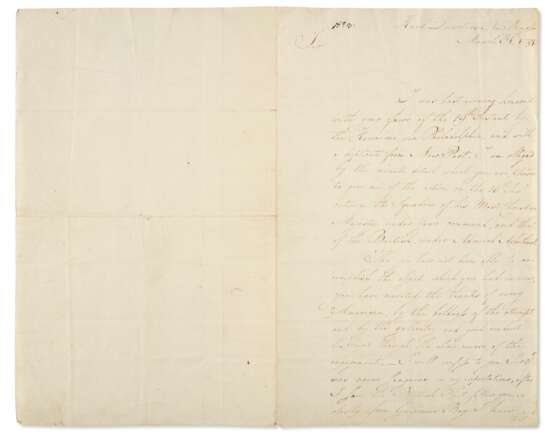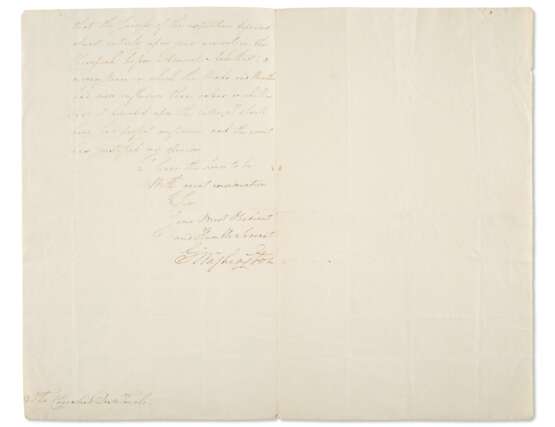ID 517692
Lot 46 | To Destouches on his failed expedition to the Chesapeake
Valeur estimée
$ 30 000 – 50 000
Two pages, bifolium, 318 x 199mm.
Washington commiserates with Destouches over his failed attempt to send reinforcements to Virginia. On the evening of 8 March, Destouches sailed from Newport in an attempt reinforce Virginia’s defense against raids by the turncoat Benedict Arnold. His forces were to link up with another column under Lafayette then preparing to march overland to Virginia. British Admiral Arbuthnot, stationed in Gardiner's Bay, detected the French sailing and followed in pursuit a day and a half later. Due to their ships' copper bottoms, Arbuthnot arrived at the mouth of Chesapeake Bay, just before the French. A battle ensued off Cape Henry on 16 March, and after an hours-long engagement, the British gained control of the bay, enabling them to send further reinforcements to Virginia to bolster Arnold’s forces.
Washington thanks Destouches for “the minute detail which you are pleased to give me on the Action of the 16th Inst. between the Squadron of his Most Christian Majesty under your command and that of the British under Admiral Arbuthnot. 'Tho you have not been able to accomplish the object which you had in view, you have merited the thanks of every American by the boldness of the attempt, and by the gallantry and good conduct displayed through the whole course of the engagement.—I will confess to you, Sir, I was never Sanguine in my expectations after I saw the British Fleet follow you so closely from Gardiners Bay. I knew that the success of the expedition depended almost intirely upon your arrival in the Chesapeak before Admiral Arbuthnot—A circumstance in which the Winds and Weather had more influence than valour or skill—Had it depended upon the latter, I should have had perfect confidence, and the event has justified my opinion. I have the honor to be with very great consideration…"
While he offered his sympathies to Destouches, Washington wrote more frankly to his cousin Lund Washington at Mount Vernon, expressing his frustrations with the failed expedition and placing the blame on French delays that prevented Arnold’s defeat in Virginia. The British intercepted that letter and published it inRivington's Gazette much to Washington's mortification. On reading the letter in print, Rochambeau sent a stern protest to Washington, and following a lengthy explanation of the points of contention, concluded by challenging Washington to "give me answer to all the points, with all the candor which distinguishes your Character." Washington responded with an apology and clarification: "I feel extreme pain at the occasion of that part of your letter of the 26th Inst. which relates to an intercepted letter of mine published by the enemy. I am unhappy, that an accident should have put it in their power to give to the world any thing from me, which may contain an implication the least disagreeable to you or to the Chevalier Des-Touche." Although he surmised that some of his words may have been altered in the press, "It would however be disingenuous in me not to acknowledge that I believe the general import to be true," but added that the "letter however was written in haste, & might have been inaccurately expressed." With that letter, the matter was dropped, despite the embarrassment. (See GW to Lund Washington, 28 March 1781 & 30 April 1781 in Fitzpatrick, Writings, Vol. 21, p. 385 & Vol. 22, p. 16; Rochambeau to GW, 26 April 1781, George Washington Papers, Series 4, General Correspondence, Library of Congress. Interestingly, in Washington’s 30 April letter to Rochambeau, he cites a lack of a retained copy of the letter to compare to what was published in Rivington's Gazette. Yet a full transcript can be found in Varick’s letter books. See George Washington Papers, Series 3, Varick Transcripts, 1775-1785, Subseries 3H, Personal Correspondence, 1775-1783, Letterbook 2: 2 January 1780 – 18 December 1782, Ibid.) Provenance: Charles-René-Dominique Sochet Destouches (1727-1793) – by descent to the consignor.
| Adresse de l'enchère |
CHRISTIE'S 20 Rockefeller Plaza 10020 New York Etats-Unis | ||||||||||||||
|---|---|---|---|---|---|---|---|---|---|---|---|---|---|---|---|
| Aperçu |
| ||||||||||||||
| Téléphone | +1 212 636 2000 | ||||||||||||||
| Fax | +1 212 636 4930 | ||||||||||||||
| Conditions d'utilisation | Conditions d'utilisation | ||||||||||||||
| transport |
Service postal Service de messagerie ramassage par vous-même | ||||||||||||||
| Modes de paiement |
Virement bancaire | ||||||||||||||
| Heures d'ouverture | Heures d'ouverture
|




